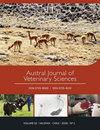Mycoplasma isolation in milk samples from dairy herds in Chile
IF 0.8
4区 农林科学
Q3 VETERINARY SCIENCES
引用次数: 0
Abstract
. Mycoplasma bovine mastitis is a highly contagious disease, usually associated with clinical cases refractory to antibiotic treatment. The aim of this study was the isolation of Mycoplasma species in cattle milk samples from dairy herds in Chile. Bulk tank milk samples selected by convenience from 91 Holstein Friesian dairy herds located in Los Rios (66) and Los Lagos (25), the two most important dairy Regions in the country, were collected. Additionally, 100 individual milk samples from cows with a high incidence of clinical mastitis, refractory to antibiotic therapy, and negative bacteriological results for traditional mastitis pathogens, all from the Biobío Region and received in our diagnostic laboratory, were included. All samples were cultured for 10 days on PPLO medium. The differentiation of suspect colonies between genus Mycoplasma and Acholeplasma was performed by the digitonin test and a specific PCR. The species identification was performed by a M. bovis specific PCR and 16S rRNA sequencing. Mycoplasma was isolated from 3 (3.3%) bulk tank milk samples and 2 (2%) individual cow milk samples. All colonies were identified as Mycoplasma by the digitonin test and by a specific PCR. At species level, one strain isolated from a bulk tank milk sample was identified as M. bovis . The remaining two strains isolated from bulk tank milk samples were identified as M. bovigenitalium , while the two strains isolated from milk of individual cows were identified as M. alkalescens . These results show that not only M. bovis is present in Chilean dairy herds, but also other pathogenic species not previously described in Chile such as M. bovigenitalium and M. alkalescens , which pose a potential risk for dairy herds in southern Chile.智利奶牛群牛奶样本中支原体的分离
. 牛支原体乳腺炎是一种高度传染性疾病,通常与临床病例难抗生素治疗有关。本研究的目的是从智利奶牛群的牛奶样品中分离支原体。为了方便起见,从位于洛斯里奥斯(66)和洛斯拉各斯(25)这两个最重要的奶业地区的91头荷斯坦弗里西亚奶牛群中选择了散装罐奶样本。此外,我们还纳入了100例乳腺炎临床高发、抗生素治疗难治、传统乳腺炎病原体细菌学结果阴性的奶牛的牛奶样本,这些样本均来自Biobío地区,并在我们的诊断实验室收到。所有样品在PPLO培养基上培养10天。采用地黄皂苷试验和特异性PCR对支原体和无支原体可疑菌落进行鉴定。采用牛分枝杆菌特异性PCR和16S rRNA测序进行种属鉴定。从3份(3.3%)散装罐乳样品和2份(2%)个体牛奶样品中分离到支原体。所有菌落均经地黄皂苷检测和特异PCR鉴定为支原体。在种水平上,从散装罐乳样品中分离的一株菌株被鉴定为牛分枝杆菌。从散装罐乳样品中分离得到的2株菌株鉴定为bovigenitum,从奶牛个体乳中分离得到的2株菌株鉴定为碱性分枝杆菌。这些结果表明,智利奶牛群中不仅存在牛分枝杆菌,而且还存在以前未在智利描述的其他致病物种,如牛分枝杆菌和碱性分枝杆菌,它们对智利南部的奶牛群构成潜在风险。
本文章由计算机程序翻译,如有差异,请以英文原文为准。
求助全文
约1分钟内获得全文
求助全文
来源期刊

Austral Journal of Veterinary Sciences
Veterinary-General Veterinary
CiteScore
1.60
自引率
0.00%
发文量
18
期刊介绍:
Austral Journal of Veterinary Sciences (formerly Archivos de Medicina Veterinaria) publishes original scientific contributions in English, containing the latest developments and discoveries in veterinary sciences. The journal covers topics such as animal health and production, preventive medicine, zoonosis, pharmacology and therapeutics, methods of diagnosis, and other areas related to the veterinary field.
Austral Journal of Veterinary Sciences aims to divulge information about advances in veterinary medicine among universities, research centres, industries, government agencies, biologists, agronomists and veterinarians.
 求助内容:
求助内容: 应助结果提醒方式:
应助结果提醒方式:


